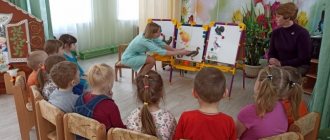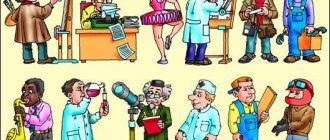Summary of GCD in the senior group on the topic: “Sound F”
Abstract of GCD on the topic: “Sound F”
The lesson notes can be used by speech therapists when introducing children to the sound F in the senior compensatory group.
Purpose: 1. To introduce children to the sound F. To teach them to distinguish the sound among other sounds as part of a word. Learn to analyze the syllable FU, the sound series AFA. 2. Consolidate knowledge on the topic “Wild Animals”. Improve the ability to select adjectives for nouns. 3. Develop auditory perception. 4. Cultivate a desire to study. Material: sound cubes, sound F, object pictures for the sound F, animal toys, forfeits. Progress: 1. – Name the first sound in the word: JAR, SHELF, PEONY, BINOCULS, ECHO, HIVE, PANAMA, BOW, COCK, BANDAGE, CLOUD 2. Work on the sound F: – Today we will get acquainted with a new sound. What sound is repeated in the words: VEIL, FOUNTAIN, PHEASANT (Sound F). — Say the sound F. Is the F sound a vowel or a consonant? (The sound F is a consonant because it is not sung.) - What stops you from singing it? (Upper teeth and lower lip). — Let’s check the neck, is the F sound voiced or unvoiced? (The F sound is dull because the bell does not ring in the neck when we pronounce it.) - Today the F sound is in the blue shirt because it is hard. - Tell us everything about the sound F (The sound F is a consonant, deaf, hard). — A bear magician came to visit with the sound F. He will teach you how to do magic tricks. Pick up the blue flags. When you hear the sound F in the word, raise the flag up: WANDER, DESK, BEADS, JOITHER, FLANK, VASE, FLAGGER, PENICAL CASE, TICKET, FLEET. MAC - The magician has prepared another game for you. “Repeat the chain of syllables and get a forfeit”: FA-FO-FA FU-FY-FU FE-FA-AF OF-OF-UF FA-FU-FA FY-FO-FY - Who is depicted on your forfeits? (Wolf). - What animal is a wolf? (Wolf is a wild animal). - What kind of wolf? (The wolf is gray, big, predatory, hungry). -Where does the wolf sleep? (The wolf sleeps in the den). —What are the names of the cubs of a she-wolf and a wolf? (wolf cubs). - The wolf has prepared his task for you. You need to lay out the syllable FU from the cubes. - What is the first sound in the syllable FU? (In the syllable FU, the first sound is F. The sound F is a consonant, deaf, hard). - What is the second sound in the syllable FU? (In the syllable FU the second sound is U. The sound U is a vowel). - Connect the sounds and read the syllable. Where is the sound F in the syllable FU? (In the syllable FU, the F sound is at the beginning of the syllable.) — You correctly laid out the syllable FU and talked about the sounds. Get forfeits from the wolf. Who is depicted on the forfeits? (Fox). — Tell us about the fox (The fox is a wild animal. The fox sleeps in a hole. The fox has cubs). — Fox, which one? (The fox is red, big, fluffy, predatory, cunning). — Lisa has prepared her task for you: to lay out the sound series of AFA from the cubes. - Say a row (AFY). — What was the first sound you played on the track? (The first sound is A. The sound A is a vowel). - Name the second sound in the series AFY (Second sound F. The sound F is a consonant, deaf, hard). - What is the third sound in the series? (The third sound is Y. The sound Y is a vowel). - How many sounds are there in the AFA row? (There are three sounds in the AFA series). - Name the consonant sound in the series (Sound F). - Where is the sound F in the series AFY? (The F sound is in the middle of the row.) — Lisa wants to remind you how to read this sound series correctly. Place your right index finger on the cube with the sound A. Say the sound. Place your finger on the cube with the sound F and prepare your lips to pronounce the sound Y. Connect the syllable (FY). Read the entire series (A-A - FY - Y). - Where is the sound F in the series AFY? (In the AFA row, the sound F is in the middle of the row.) - Get forfeits from the fox. Who is depicted on these forfeits? (Hare). - What kind of hare? (Gray, small, fluffy, herbivore, cowardly, fast). -Where does the hare sleep? (In the forest, under a bush). —What are the baby hare's called? (Little bunnies). — The hare brought you cameras so that you could photograph his favorite pictures. Finger gymnastics “Photographers”. - Take cameras (children bring the collected fingers of their right and left hands to their eyes), take a photo of the first picture, the second, third, fourth - touch the tip of the thumb to the index finger (fountain, jacket, telephone, magician). - Let's develop the film (children clench their hands into fists, spread their fists to the sides), - Let's print the pictures (children clap their hands four times). - Let's see what kind of pictures we got (one child names the pictures in the correct sequence) FOUNTAIN, JACKET, PHONE, MAGICIAN SHOES, FLANK, FOOTBALL PLAYERS, BEANS T-SHIRT, LANTERN, BOTTLES, FRUIT - What are beans? (Beans are a vegetable). — What is a bottle? (A bottle is a glass jar for perfume). - For completing the task correctly, you will receive forfeits from the hare. — Who is depicted on the next forfeit? (Hedgehog). - Tell us what you know about the hedgehog (A hedgehog is a wild animal, the hedgehog sleeps in a hole. The baby hedgehogs are hedgehogs. The hedgehog is a predatory animal. The hedgehog feeds on mice, worms, and beetles). - What kind of hedgehog? (The hedgehog is gray, small, prickly, predatory). - The hedgehog wants to play with you. 3. Physical education minute. The bear showed us a trick - roll from one leg to the other. The hare brought a camera - jumping on the spot. The wolf bought aprons - hands on the belt, bending to the sides. The hedgehog brought a cart of fruit - sit down, hugging your knees 4. The bear - the magician loves to sail on a ship. He wants you to learn Marshak's poem with the sound F: The fleet is sailing to its native land, A flag on every ship 5. Color the Russian flag on the ship (Children color the flags in their workbooks). 6. Summary of the lesson. Tell us all about the sound F.
We recommend watching:
Synopsis of an individual speech therapy lesson in a senior group Synopsis of an individual educational activity with a 5-6 year old pupil for the correction of sound pronunciation Synopsis of an educational activity in a senior group with a compensatory focus Abstract of a developmental lesson for children 6-7 years old
Similar articles:
Summary of a comprehensive lesson on familiarization with the outside world and development of speech “Wintering Birds” in the senior group of a preschool educational institution
Lesson notes for the GPD. Cuttings of indoor plants
![Producing the sound [L] to a child in stages. Articulation gymnastics, speech therapy exercises, pronunciation lessons with pictures](https://doktorobrubov.ru/wp-content/uploads/postanovka-zvuka-l-rebenku-poetapno-artikulyacionnaya-gimnastika-logopedicheskie-uprazhneniya-uroki-330x140.jpg)




